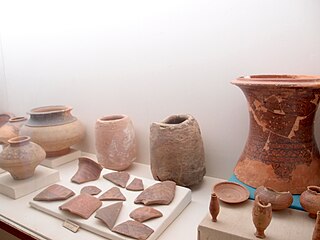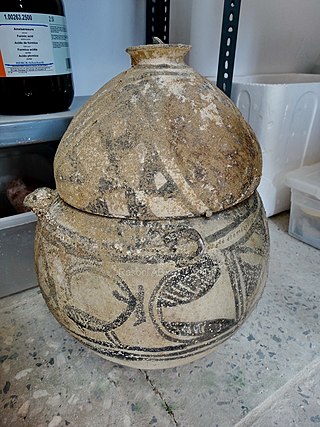
Harappa is an archaeological site in Punjab, Pakistan, about 24 kilometres west of Sahiwal. The Bronze Age Harappan civilisation, now more often called the Indus Valley Civilisation, is named after the site, which takes its name from a modern village near the former course of the Ravi River, which now runs eight kilometres to the north. The core of the Harappan civilisation extended over a large area, from Gujarat in the south, across Sindh and Rajasthan and extending into Punjab and Haryana. Numerous sites have been found outside the core area, including some as far east as Uttar Pradesh and as far west as Sutkagen-dor on the Makran coast of Balochistan, not far from Iran.

Mehrgarh is a Neolithic archaeological site situated on the Kacchi Plain of Balochistan in modern-day Pakistan. It is located near the Bolan Pass, to the west of the Indus River and between the modern-day Pakistani cities of Quetta, Kalat and Sibi. The site was discovered in 1974 by the French Archaeological Mission led by the French archaeologists Jean-François Jarrige and Catherine Jarrige. Mehrgarh was excavated continuously between 1974 and 1986, and again from 1997 to 2000. Archaeological material has been found in six mounds, and about 32,000 artifacts have been collected from the site. The earliest settlement at Mehrgarh, located in the northeast corner of the 495-acre (2.00 km2) site, was a small farming village dated between 7000 BCE and 5500 BCE.

The 3rd millennium BC spanned the years 3000 to 2001 BC. This period of time corresponds to the Early to Middle Bronze Age, characterized by the early empires in the Ancient Near East. In Ancient Egypt, the Early Dynastic Period is followed by the Old Kingdom. In Mesopotamia, the Early Dynastic Period is followed by the Akkadian Empire. In what is now Northwest India and Pakistan, the Indus Valley civilization developed a state society.

The Indus Valley Civilisation (IVC), also known as the Indus Civilisation, was a Bronze Age civilisation in the northwestern regions of South Asia, lasting from 3300 BCE to 1300 BCE, and in its mature form from 2600 BCE to 1900 BCE. Together with ancient Egypt and Mesopotamia, it was one of three early civilisations of North Africa, Southwest Asia and South Asia, and of the three, the most widespread, its sites spanning an area including much of modern-day Pakistan, northwestern India and northeast Afghanistan. The civilisation flourished both in the alluvial plain of the Indus River, which flows through the length of Pakistan, and along a system of perennial monsoon-fed rivers that once coursed in the vicinity of the Ghaggar-Hakra, a seasonal river in northwest India and eastern Pakistan.

Shahr-e Sukhteh, c. 3550–2300 BC, also spelled as Shahr-e Sūkhté and Shahr-i Sōkhta, is an archaeological site of a sizable Bronze Age urban settlement, associated with the Helmand culture. It is located in Sistan and Baluchistan Province, the southeastern part of Iran, on the bank of the Helmand River, near the Zahedan-Zabol road. It was placed on the UNESCO World Heritage List in June 2014.
Rehman Dheri or sometime Rahman Dheri is a Pre-Harappan Archaeological Site situated near Dera Ismail Khan in the Khyber Pakhtunkhwa province of Pakistan. This is one of the oldest urbanised centres found to date in South Asia. Dated, the site is situated 22 kilometres (14 mi) north of Dera Ismail Khan. It is on the Tentative List for future World Heritage Sites in Pakistan.

Amri is an ancient settlement in modern-day Sindh, Pakistan, that goes back to 3600 BCE. The site is located south of Mohenjo Daro on Hyderabad-Dadu Road more than 100 kilometres north of Hyderabad, Pakistan.
Several periodisations are employed for the periodisation of the Indus Valley Civilisation. While the Indus Valley Civilisation was divided into Early, Mature, and Late Harappan by archaeologists like Mortimer Wheeler, newer periodisations include the Neolithic early farming settlements, and use a stage–phase model, often combining terminology from various systems.
Amri–Nal culture is attributed to Amri archaeological sites in Sindh and Balochistan provinces of Pakistan. It flourished in the 4th and 3rd millennia BC. The dual typesites are Amri and Sohr Damb area in Naal, Balochistan.
Muhammad Rafiq Mugal is a Pakistani archaeologist, engaged in investigating of ethnoarchaeological research in Chitral, northern Pakistan. He has been responsible for the direction, technical support and supervision for restoration and conservation of more than thirty monuments and excavated remains of the Islamic, Buddhist and Proto-historic periods, in Punjab, Khyber-Pakhtunkhwa and Gilgit-Baltistan of Pakistan. He served as a professor of archaeology and heritage management and the director of undergraduate studies at Boston University. He is now Professor Emeritus of Archaeology at Boston University.

Pottery in the Indian subcontinent has an ancient history and is one of the most tangible and iconic elements of Indian art. Evidence of pottery has been found in the early settlements of Lahuradewa and later the Indus Valley Civilisation. Today, it is a cultural art that is still practiced extensively in the subcontinent. Until recent times all Indian pottery has been earthenware, including terracotta.

Pirak is an archaeological site belonging to the Indus Valley civilization located in Balochistan, Pakistan. It is 20 km south of Sibi east of the Nari River. The mound is 8m high and covers approximately 12 acres (4.9 ha). The site of Pirak was first reported by Robert Raikes in 1963. It was excavated, between 1968 and 1974, before the well known sites of Mehrgarh or Nausharo by the French archaeological mission team led by Jean Marie Casal. According to the excavator, this site was occupied from c.1800 BCE to 800 BCE.

Pakistan contains many of the oldest archaeological discoveries of the world. The country is home to many archaeological sites dating from Lower Paleolithic period to Mughal empire. The earliest known archaeological findings belong to the Soanian culture from the Soan Valley, near modern-day Islamabad. Soan Valley culture is considered as the best known Palaeolithic culture of Central Asia.
Periano Ghundai meaning "The Hill of Fairies" was an archaeological mound located in the Zhob district in Balochistan, Pakistan. The site is located 3 kilometres (1.9 mi) west of the town of Zhob. It was excavated in 1924 by Sir Aurel Stein and showed great resemblance to the Harappan culture.

Sohr Damb, c. 3800–2300 BC, is an archaeological site, located near Nal, in central Balochistan, Pakistan that begins before the Indus Valley civilization featuring Togau, Kili Ghul Mohammad, and Kechi Beg pottery styles. It has also been known as Naal, Balochistan, and gave its name to the prehistoric Amri-Nal culture, which is attributed to the dual typesites of Amri and Nal.

Indus–Mesopotamia relations are thought to have developed during the second half of 3rd millennium BCE, until they came to a halt with the extinction of the Indus valley civilization after around 1900 BCE. Mesopotamia had already been an intermediary in the trade of lapis lazuli between the Indian subcontinent and Egypt since at least about 3200 BCE, in the context of Egypt-Mesopotamia relations.

The Helmand culture, c. 3300–2350 BCE, is a Bronze Age culture that flourished mainly in the middle and lower valley of the Helmand River, in southern Afghanistan and eastern Iran, predominantly in the third millennium BCE.
Catherine Jarrige, nee Catherine Klein, is a retired French archaeologist, best known for co-leading the discovery of Mehrgarh, a Neolithic site in Balochistan, Pakistan.















